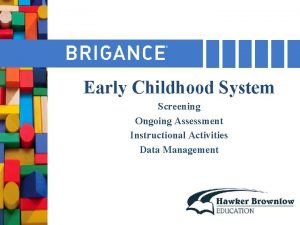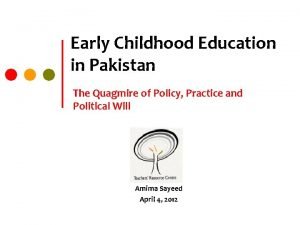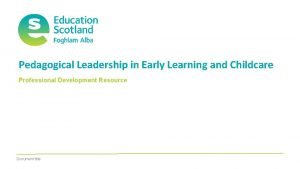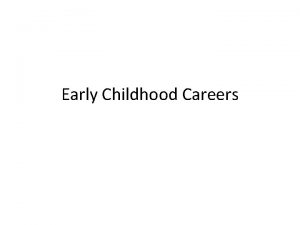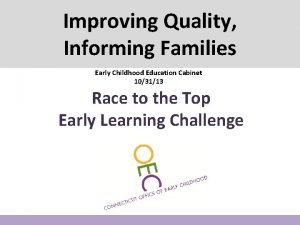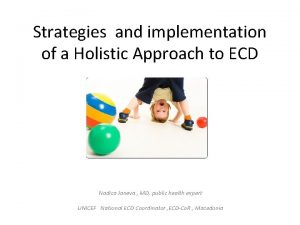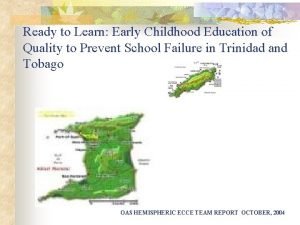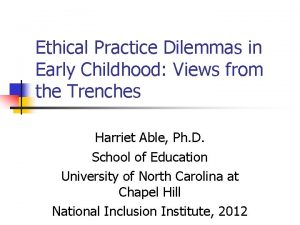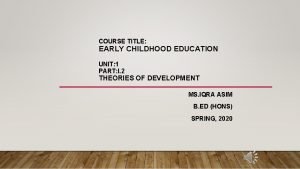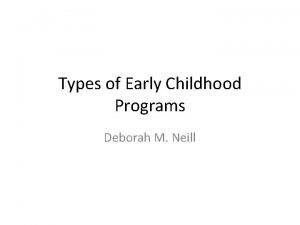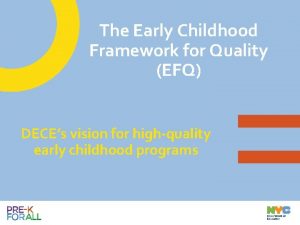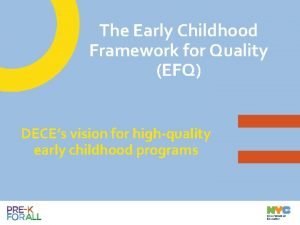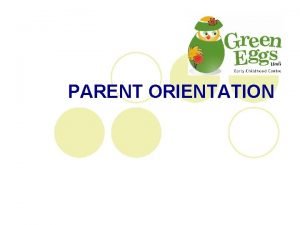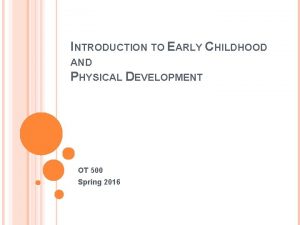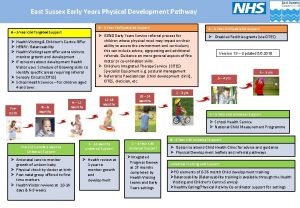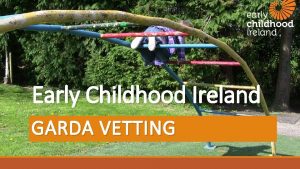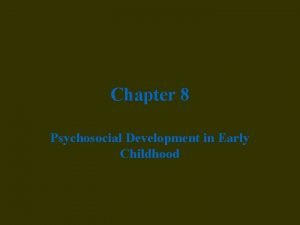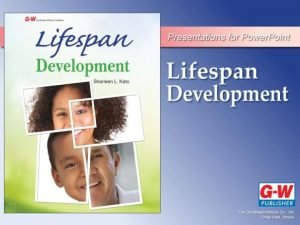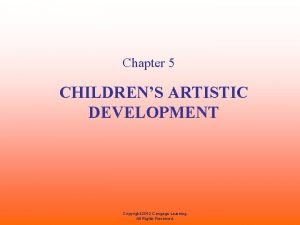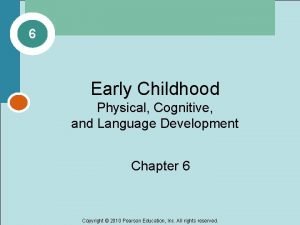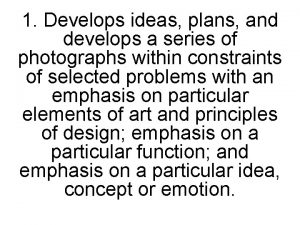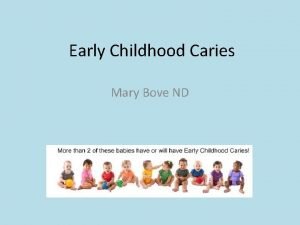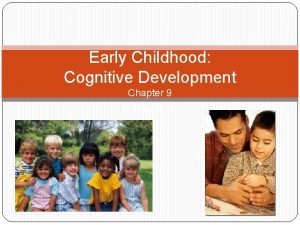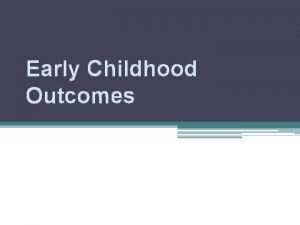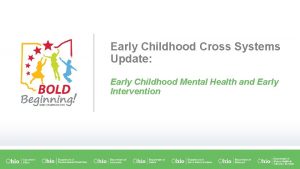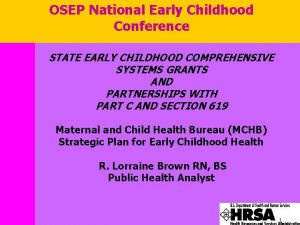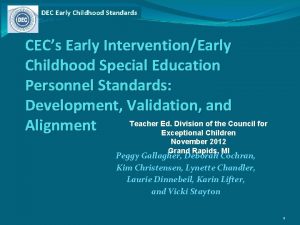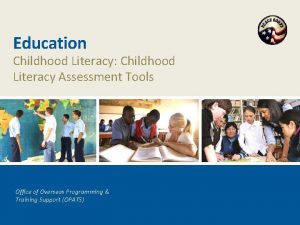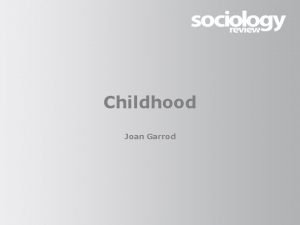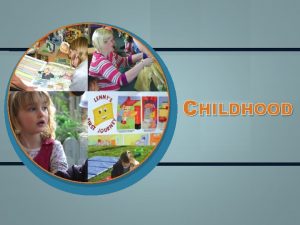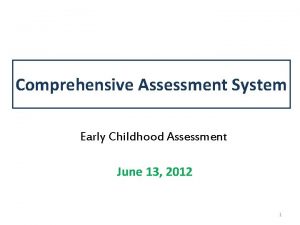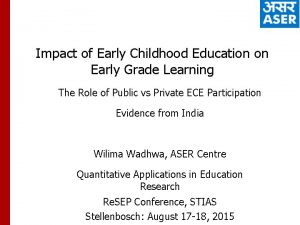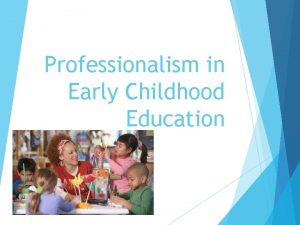What Develops Understanding Assessment in Early Childhood Education



































- Slides: 35

What Develops? Understanding Assessment in Early Childhood Education Parent-Infant Interaction, Bio-Behavior and Stress Regulation: Theory, Research, and Assessment David W. Haley, Ph. D. Postdoctoral Fellow Department of Pediatrics University of British Columbia dhaley@cw. bc. ca

Working Assumptions • • Parent-infant interactions are regulatory Biological vulnerabilities influence parent-infant interactions/regulatory systems • Parent-infant interactions/regulatory systems affect how infants interact in social/cognitive contexts

Social and Biological Factors that Influence Development Environment I. Parent-infant Regulation Arousal Affect Attention II. Alcohol Exposure III. Premature Birth Psychological Development


Still-Face Effect • Still-Face – – – social gaze negative affect heart rate (Weinberg, 1996) (Tronick, Als, Brazelton, 1978)

Reunion: – social gaze – negative affect – heart rate (Weinberg, 1996) “partial recovery”

Still-Face and Reunion • Still-Face • (Tronick et al. , 1978) • Reunion as Recovery • (Weinberg & Tronick, 1996) • Quality of parent-infant interaction predicts infant responses • (Carter & Mayes, 1990; Braungart et al. , 2000)

Parent Behavior Infant’s: – social gaze (Kogan & Carter, 1996) – negative affect (Braungart et al. , 2001)

Aims Will parent responsiveness moderate the infant’s ability to regulate stress? Will Still-Face Reunion procedure be sufficiently stressful to elicit a cortisol response in infants?

Independent Variables 2 (Parent Responsiveness) x 5 (Episode) with Repeated Measures: – Parent Responsiveness: high/low groups – Episode: Play 2 min Still-Face I 2 min Reunion Still-Face Reunion I II II 2 min

Cortisol response to SFP (N = 43), F(1, 39)=8. 30, p<. 001

Social Attend differs by Group, F(1, 39) = 6. 10, p<. 05. (N = 43)

Negative Affect differs by Group x Episode, F(3, 101), p <. 05. (N=43)

Heart Rate differs by Group x Episode, F(3, 98) = 4. 31, p <. 01. (N=42)

Conclusions • Infant HPA, cardiovascular, emotional, and social responses sensitive to procedure • Infant ability to regulate stress decreases with repeated stressors • Parent responsiveness moderates infant ability to regulate stress

Parent-Infant Interaction and Maternal Drinking

University of New Mexico Principal Investigator Nancy Handmaker, Psychology Co-Investigator* & Collaborators Stan Handmaker*, Pediatrics Brittany Raybrun, Ob. Gy Rappaport, Ob. Gy Jean Lowe, Developmental William Zywiak, Stats Support NIH NIAAA; CRC Research Staff Hillary Heyl Janette Schluter Research Assistants Chen Meng Amir Wodajo Brandi Proctor Melissa Ramsey Rrittany Rayburn Jennifer Bennett Trainees Sharon Mc. Caul, MA Jordan Bell, MS

Background: Effects of Moderate Alcohol Exposure (>0. 5 oz absolute alcohol/day) • • Growth deficits IQ Learning problems Behavior problems • Biobehavior – – – HPA Sympathetic Adrenal Medulla Affect Attention Emotional Disorders

HPA Axis Stressors Hippocampus Social Cognitive Physical Emotional (-) Hypothalamus CRF (-) (+) Pituitary Gland ACTH Cortisol (+) Adrenal Glands Cortisol

Drinking from conception to knowledge of pregnanc & awareness until birth (N=54) Pre-aware Post-aware Average # of drinks per day 2. 27 (3. 38) [0 -22. 13] . 11 (. 33) [0 -2. 13] Average # of drinks per drinking day 6. 97 (6. 04) [0 -31] 1. 80 (4. 30) [0 -29] Average blood alcohol content (BAC; mg/dl) 37. 63 (55. 93) [0 -291. 33] 1. 70 (5. 43) [0 -28. 34] 0. 290 (. 11) [0 -1. 00] . 119 (. 03) [0 -. 19] Percent of days drinking (%)

Cortisol Reactivity predicted by Maternal Drinking (†), adjusted R²=. 15 (n=38) (†) after adjusting for gender & days until awareness • Removing mothers who continued to drink (n=11), R²=. 11 • Removing mothers who drank ≥ 5 drinks (n=5), R²=. 09

Multiple Stress Systems: Heart Rate and Negative Affect by Drinking Heart Rate by drinking, adj. R²=. 15, after Negative Affect by drinking, adj. R²=. 06 , after adjusting for gender and days until aware, adjusting for gender, R² =. 14 (n=50) (n= 33)

Conclusion • Moderate to High drinking from conception to awareness of pregnancy associated with: – Greater cortisol reactivity – Elevated heart rate during recovery – Greater negative affect

Parent-Infant Interaction Assessed via Infant Cognition (Contingency Learning)

Working Assumptions

Biobehavioral Responses to Painful Stressors in Preterm Infants (Grunau, 2001) • 8 -month-old (corrected) preterm & full-term • Elevation of heart rate in preterm • Neonatal stress linked to alterations in cardiac & facial activity (r’s. 45 -. 53)

Question? Given that preterm infants have learning difficulties and show biobehavioral differences – Is contingency learning a biobehavioral challenge for preterms? – Is contingency learning more of a biobehavioral challenge for slow vs. fast learners?

Participants 3 -month-old infants 47 preterms corrected for age 54 full-term controls Conception Preterm Full-term 3 months Gestation ≤ 32 weeks 36 -42 weeks

Kicking by Group x Phase, p<. 001

Kicking by Group x Speed x Phase, p<. 001

Vagal Tone by Group x Speed, p<. 01.

Conclusion • Learning is a biobehavioral challenge for infants • Learning is a greater biobehavioral challenge for preterm and slow learners

Working Assumptions Restated • Parent-infant interactions are regulatory • Biological vulnerabilities influence parent-infant interactions/regulatory systems • Parent-infant interactions/regulatory systems affect how infants interact during social/cognitive contexts

University of British Columbia Primary Investigator Ruth Grunau, Psychologist Co-ordinator Colleen Fitzgerald Co-Investigators Michael Whitfield, Neonatologist Tim Oberlander, Pediatrician Joanne Weinberg, Neuroscientist Alfonso Solimano, Neonatologist Manager, SCN Project Adi Amir Graduate Trainees Liisa Holsti (CIHR) Julie Petrie-Thomas (CIHR, MSFHR) Research Staff Mary Beckingham Zoe Raffard Research Staff Taryn Fay Kristin Fay Gisela Gosse, RN Colleen Jantzen Andrew Macquistan Carol Stephanson

Institutions Centre for Community Child Health Research, British Columbia Research Institute, University of British Columbia Department of Pediatrics, University of British Columbia Funding Sources: NICHD, CIHR, HELP, MSFHR
 Middle childhood is from
Middle childhood is from Ongoing assessment early childhood
Ongoing assessment early childhood Suny pdp
Suny pdp Early childhood directorate
Early childhood directorate Trends in early childhood education
Trends in early childhood education Early childhood education in pakistan
Early childhood education in pakistan Early childhood education in bangladesh
Early childhood education in bangladesh Pedagogical leadership skills
Pedagogical leadership skills Associates in early childhood education jobs
Associates in early childhood education jobs Early childhood education barbados
Early childhood education barbados Queen's university early childhood education
Queen's university early childhood education Connecticut early childhood education cabinet
Connecticut early childhood education cabinet Skinner's operant learning theory
Skinner's operant learning theory Holistic approach in early childhood education
Holistic approach in early childhood education Swot analysis early childhood education
Swot analysis early childhood education Ethical dilemmas in early childhood education
Ethical dilemmas in early childhood education Early childhood education
Early childhood education Bf skinner early childhood education
Bf skinner early childhood education Three types of early childhood programs
Three types of early childhood programs Types of early childhood programs activity a chapter 2
Types of early childhood programs activity a chapter 2 Efq framework
Efq framework Early childhood framework for quality
Early childhood framework for quality Green eggs early childhood centre
Green eggs early childhood centre Leonardo da vinci early childhood
Leonardo da vinci early childhood Fine motor skills development in early childhood
Fine motor skills development in early childhood Physical development in early childhood
Physical development in early childhood Early childhood research quarterly author guidelines
Early childhood research quarterly author guidelines Garda vetting form early childhood ireland
Garda vetting form early childhood ireland Psychosocial development in early childhood
Psychosocial development in early childhood Chapter 7 early childhood ages 3 through 5 answer key
Chapter 7 early childhood ages 3 through 5 answer key Kellogg's developmental stages of art for early childhood
Kellogg's developmental stages of art for early childhood Character traits of amelia earhart
Character traits of amelia earhart Language development in early childhood
Language development in early childhood Pakistan alliance for early childhood
Pakistan alliance for early childhood Isaac newton early childhood
Isaac newton early childhood Eminem early childhood
Eminem early childhood

